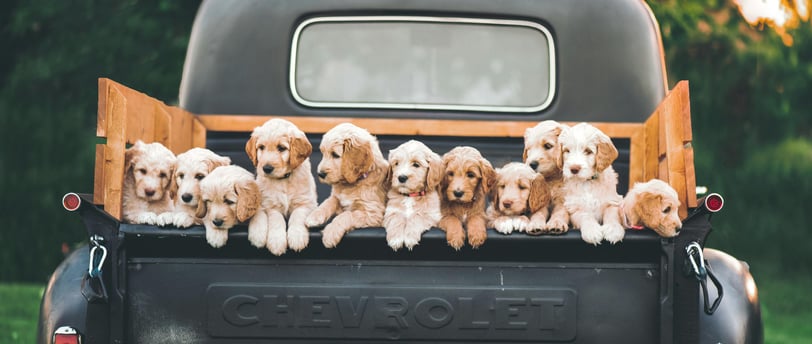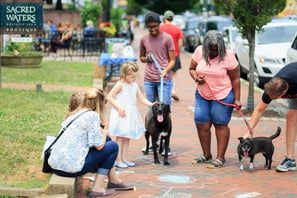The Importance of Socialization: Essential Tips for Handlers
Ensure your service dog is well-prepared for any situation with our guide to socialization techniques, including step-by-step tips for gradual exposure and other importance information.
TRAINING TIPS
Crysta Germany
9/2/20246 min read


The Importance of Socialization
Training a service dog is more than just teaching them commands and tasks; it's about preparing them to navigate the world confidently and calmly. Service dogs are expected to encounter a wide variety of people, animals, places, and situations. It's unrealistic to expect a dog to be comfortable in every new environment right away. This is where socialization becomes crucial.
Why Socialization Matters
Service dogs aren't robots; they're dogs with jobs. While they are trained to perform specific tasks, they still have natural instincts and behaviors. It's normal for them to react to new stimuli or make mistakes. A well-socialized service dog knows how to remain calm and focused, trusting its handler to guide it through new or challenging situations. The key to achieving this level of trust and focus is gradual exposure and consistent training.
Take Your Time
When it comes to socializing your service dog, patience is essential. Socialization takes time, and it's unlikely that you'll find a perfectly trained dog right from the start, especially if you're training a dog on your own. It can certainly be frustrating at times, but remember that every step forward, no matter how small, is progress.
A Step-by-Step Approach
1. Start at Home: Begin teaching your dog to focus on you in a controlled, familiar environment- your home. Practice commands to ensure your dog understands that their attention should always return to you, regardless of any distractions.
2. Move Outside: Once your dog is comfortable focusing on you indoors, start practicing outside. Dogs can sometimes have trouble generalizing their training across different environments, so it's important to reinforce these behaviors in new settings.
3. Visit Dog-Friendly Areas: Gradually introduce your dog to dog-friendly environments like parks or pet-friendly stores. These locations are perfect for practicing socialization with both people and other dogs. Start with quieter areas and slowly work up to more populated spots.
4. Advance to Non-Pet-Friendly Places: Once your dog is comfortable in dog-friendly areas, you can begin to visit places where other dogs might not be present, but people and various distractions are common. This helps your dog learn to ignore distractions and stay focused on their tasks.
Techniques for Effective Socialization
One effective technique is to start by observing from a distance. For example, if you're at a dog park, begin by sitting outside and away from the fenced area. Allow your dog to observe other dogs from a safe distance where they feel comfortable. As they relax and possibly start to lose interest in the dogs, you can gradually move closer. This same method can be applied in busy areas like malls. Start in a quieter section, and as you dog shows signs of calmness, gradually move towards busier areas.
It's also crucial to teach your dog to ignore people, not just other dogs. Many dogs may initially expect attention or petting from someone who walks by. Training your dog to remain focused on you regardless of human distractions is a key part of their role as a service dog.
The Importance of Gradual Exposure
Remember, gradual exposure is key. Throwing your dog into a crowded, high-traffic area too soon can overwhelm them, and cause setbacks in your training. Trust your instincts and pay attention to your dog's behavior. If they seem overly stressed or anxious, take a step back and give them time to adjust. The most important thing is to build that foundation of trust and confidence, and a part of that is finding a comfortable pace for your dog.
Conclusion
Socialization is a fundamental part of training a service dog. It helps them learn to navigate different environments with confidence and focus, which is essential for performing their duties effectively. By taking your time, gradually exposing your dog to know experiences, and reinforcing positive behaviors, you're setting them up for success. Keep in mind, every dog is unique, and it's important to tailor your approach to their individual needs and comfort levels.
Photo Credit: tina nord, blue bird, Micheal morse on pexels
The Importance of Socialization
Training a service dog is more than just teaching them commands and tasks; it's about preparing them to navigate the world confidently and calmly. Service dogs are expected to encounter a wide variety of people, animals, places, and situations. It's unrealistic to expect a dog to be comfortable in every new environment right away. This is where socialization becomes crucial.
Why Socialization Matters
Service dogs aren't robots; they're dogs with jobs. While they are trained to perform specific tasks, they still have natural instincts and behaviors. It's normal for them to react to new stimuli or make mistakes. A well-socialized service dog knows how to remain calm and focused, trusting its handler to guide it through new or challenging situations. The key to achieving this level of trust and focus is gradual exposure and consistent training.
Take Your Time
When it comes to socializing your service dog, patience is essential. Socialization takes time, and it's unlikely that you'll find a perfectly trained dog right from the start, especially if you're training a dog on your own. It can certainly be frustrating at times, but remember that every step forward, no matter how small, is progress.
A Step-by-Step Approach
1. Start at Home: Begin teaching your dog to focus on you in a controlled, familiar environment- your home. Practice commands to ensure your dog understands that their attention should always return to you, regardless of any distractions.
2. Move Outside: Once your dog is comfortable focusing on you indoors, start practicing outside. Dogs can sometimes have trouble generalizing their training across different environments, so it's important to reinforce these behaviors in new settings.
3. Visit Dog-Friendly Areas: Gradually introduce your dog to dog-friendly environments like parks or pet-friendly stores. These locations are perfect for practicing socialization with both people and other dogs. Start with quieter areas and slowly work up to more populated spots.
4. Advance to Non-Pet-Friendly Places: Once your dog is comfortable in dog-friendly areas, you can begin to visit places where other dogs might not be present, but people and various distractions are common. This helps your dog learn to ignore distractions and stay focused on their tasks.
Techniques for Effective Socialization
One effective technique is to start by observing from a distance. For example, if you're at a dog park, begin by sitting outside and away from the fenced area. Allow your dog to observe other dogs from a safe distance where they feel comfortable. As they relax and possibly start to lose interest in the dogs, you can gradually move closer. This same method can be applied in busy areas like malls. Start in a quieter section, and as you dog shows signs of calmness, gradually move towards busier areas.
It's also crucial to teach your dog to ignore people, not just other dogs. Many dogs may initially expect attention or petting from someone who walks by. Training your dog to remain focused on you regardless of human distractions is a key part of their role as a service dog.
The Importance of Gradual Exposure
Remember, gradual exposure is key. Throwing your dog into a crowded, high-traffic area too soon can overwhelm them, and cause setbacks in your training. Trust your instincts and pay attention to your dog's behavior. If they seem overly stressed or anxious, take a step back and give them time to adjust. The most important thing is to build that foundation of trust and confidence, and a part of that is finding a comfortable pace for your dog.
Conclusion
Socialization is a fundamental part of training a service dog. It helps them learn to navigate different environments with confidence and focus, which is essential for performing their duties effectively. By taking your time, gradually exposing your dog to know experiences, and reinforcing positive behaviors, you're setting them up for success. Keep in mind, every dog is unique, and it's important to tailor your approach to their individual needs and comfort levels.
Photo Credit: tina nord, blue bird, Micheal morse on pexels








